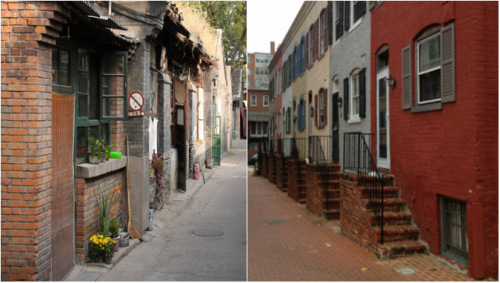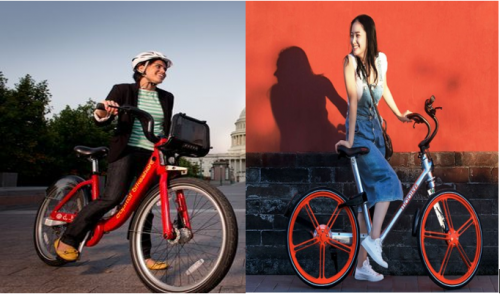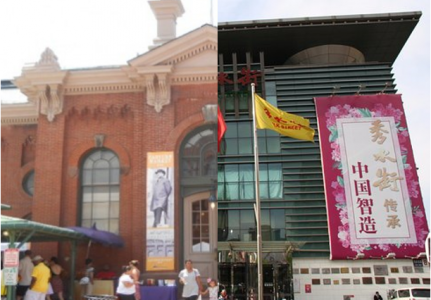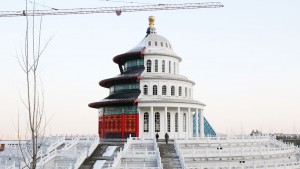A Tale of Two Cities – Comparing the American and Chinese Capitals
Project Pengyou intern, Annika London muses on the similarities and differences between her time in the Chinese and American capitals

I spent my last year of college in Washington D.C., and when I wasn’t working or studying, nothing thrilled me more than exploring the many neighborhoods of the American capital, each full of their own stories and personalities. Of course the monuments, museums, governmental buildings, and other typical attractions are worth a visit. However, it was buying street food from locals in Columbia Heights, or admiring the vibrant outdoor murals scattered among overlooked side streets of Capitol Hill, that allowed me to see the city behind the bustle of politics and tourism.
Now, as I reflect on my adventure in Beijing, I find myself naturally comparing my observations of Beijing to my memories of D.C.. When Beijing and Washington, D.C. show up in the same article, the topic is often politics or business. I believe there are other ways these two capitals are connected, all of which helped me understand and appreciate each of their cultures and beauty of these two places in greater depth.
Below are 4 observations I’ve made about some similarities between these two cities.
1. Historic Alleys

Photo 2: Life in the Alley
Both Beijing hutongs and D.C.’s residential alleys embody unique aspects of the two cities’ history and charm.
The unique, archaic architecture and multi-faceted functionality of Hutongs (ranging from residential to business) make them a special part of Beijing’s culture and history, where they have served as homes and community hubs. Now, they are also magnets for curious tourists. I’ve always felt some nostalgia while walking through these hutongs because they remind me of the residential alleys I used to explore in D.C.
In D.C., similar alleys can be found behind the elegant rowhouses that line the streets of many of the city’s residential areas. Historically, some of the alley homes were once stables and servant quarters. Especially from the late 1800s through the mid-1900s, many of the structures were homes to minority and immigrant populations who endured extreme poverty. Due to the squalid conditions, the government in the 1930s passed an act to destroy many of these structures, displacing many residents. A small percentage of the homes can were protected and can still be seen today, and many have now been renovated to become highly desired homes for upper class individuals.
2. Bicycle-friendly Cities

Photo 2: Mobike
Streets overflowing with cars are a common sight in both Beijing and D.C., and both cities are clearly encouraging citizens to use more efficient transportation options. Hence the increasing popularity in bikeshare systems. Washington’s Capital Bikeshare Program has allowed both locals and visitors to peddle all over the city for work and leisure. In Beijing as well as elsewhere in China, you can spot several different bikeshare companies like Bluegogo, Mobike, and Ofo. In cities like these where traffic congestion is common, bikes offer both flexibility and speed. And for visitors such as myself, bikes are a visually appealing way to get from one part of the city to another instead of being confined to the underground setting of a subway.
3. Street Markets and Vendors

Photo 2: Xiu Shui
Street markets may be a stereotypical expectation in Beijing, but D.C. has its own markets full of art, clothing, and trinkets. For example, I was lucky enough to live just 10 minutes away from the Eastern Market on Capitol Hill. Fresh produce (and Christmas trees during the holiday time) can be purchased from local farmers during the week. During the weekends hundreds of pedestrians come to visit the artists, clothing designers, and musicians who join the farmers in selling their products.
The Chinese capital has plenty of street food options sitting next to the entrances of hutongs, outside metro stations, or somewhere along the sidewalk of a bigger street. Beijing’s American counterpart also has a large population of street food vendors who sell a vast variety of quick meals and refreshing snacks.
4. Green Spaces

Photo 2: Alex Tucker
As much as I love big city life, I know I will always get the occasional urge to go back to the open fields and tranquil forests of my childhood. I adore the different green spaces that can be found throughout Beijing and Washington, with their trees, flowers, and sometimes even some fountains or sculptures.
When visiting the little parks like Lincoln Park in D.C. during lunch hour, I would see quite a few working professionals who maybe shared my nostalgia, spending their break on a bench watching the nature around them instead of on a phone or laptop screen. In Beijing, the essence of community is very much alive in some of the city parks where elders gather to practice tai chi, children play games, and others rest with their dogs. Even more touristy spots like Houhai still maintain their own sense of tranquility because of the lake and plant life.

What is it about cities like Beijing and Washington D.C. that makes them so magnetic? My professor in Beijing has said that beyond the history and culture, he finds himself continually pulled back to Beijing for reasons he can’t pinpoint. From my internship supervisor’s experience, people who have lived in D.C. once always seem to return to it at some future point, even if only for a temporary visit.
A portion of the attraction is easy to explain. Washington D.C. is riddled with monuments. There are historic buildings where some of the most powerful individuals in the nation have been working for centuries, and visitors can also explore old mansions where the elite families of D.C. used to live. Beijing has many of the same kinds of places, although the age of Beijing obviously stretches far beyond that of D.C.. Walking around the Temple of Heaven or the Forbidden City, it is difficult to fully picture the lives of the people who lived here centuries before European colonies in the Americas were even a remote concept. But that mysterious element is perhaps a key to its magnetic quality.
The idea of being a living part of stories as rich and symbolic as those of Beijing and Washington D.C. can certainly be a source of pride for a local. Beyond that however, maybe people want to live in these cities because of the sense of momentum that fuels both places. In Beijing, sparkling skyscrapers rest behind stone hutongs while older individuals sit and observe the lightning-paced traffic around them. In D.C., new malls stand next to tiny family-owned shops, and people rush through streets of rowhouses to the nearest metro stop. The physical and metaphorical reality of movement is everywhere in both places. Whether it’s politics, business, or academics, both cities are full of dreams, ambitions, and perceptions of opportunity. For people like me, who always feel a call to keep moving, it can be almost too easy to fall in love with Beijing and Washington.
This is just a handful of ways to consider Washington D.C. and Beijing as comparable cities, based on my own observations. What similarities do you see between these two capitals? What are some of their biggest differences? Leave a comment below and let us know your thoughts!
I am Suvo Sarkar of Emirates NBD bank. I wish to share a business proposal with you, it is in connection with your last name. Please contact me on my email at (sarkarsuvo855@gmail.com) so that i will get back to you soonest.”